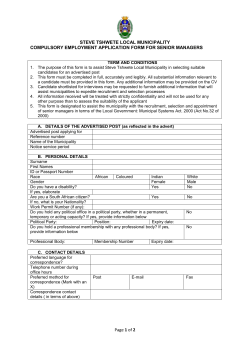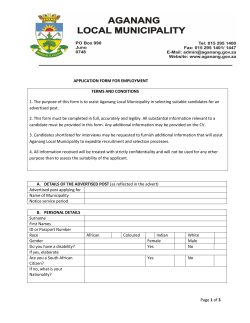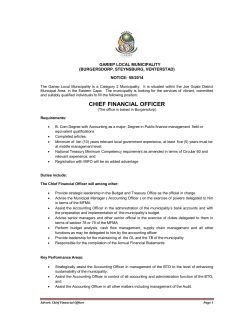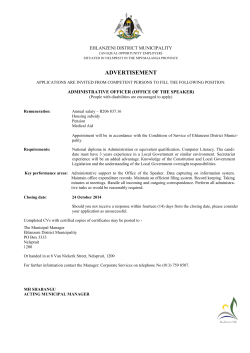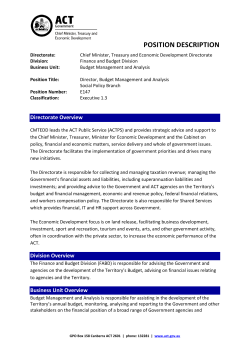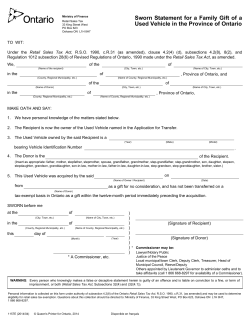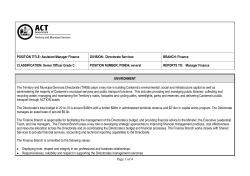
yilo krobo half year bulleting
YILO-KROBO MUNICIPAL HEALTH DIRECTORATE AT A GLANCE. VOLUME1 ISSUE1 S E P T E M B E R , 2 0 1 4 . LOCATION AND POPULATION INSIDE THIS ISSUE: RECAP OF 2013 AN- 2 NUAL HEALTH PERFORMANCE 2014 ACTIVITY IMPLEMENTATION DISTRICT HEALTH MANAGEMENT TEAM 2 2014 HALF YEAR EPI 3 PERFORMANCE RESEARCH ON NUTRI- 3 TIONAL STATUS GENERAL ACHIEVE- 3 MENTS AS AT 2014 HALF YEAR INFRASTRUCTURAL DEVELOPMENT 4 THE EDITORIAL BOARD 4 MESSAGE ON EBOLA 4 The Yilo Krobo Municipality is one of the twenty-six Districts in the Eastern Region of Ghana and is strategically located in the south eastern part of the country. It shares boundaries with Manya Krobo District in the North and East, Dangbe West and Akwapim North Districts in the South, New Juabeng, East Akim and Fanteakwa Districts in the West. The Municipality covers a land area of 805 square kilometers with Somnya as the Municipality capital. SubMunicipalities Total Pop <1yr/ Exp. Delivery <5 Years WIFA 1. Agogo 16,959 678 3,137 4,240 2. Boti 3. Bukunor 4. Nkurakan 5. Nsutapong 6. Somanya 8,772 13,938 17,934 4,971 36,843 351 558 717 199 1,474 1,623 2,578 3,318 920 6,816 2,193 3,484 4,484 1,243 9,211 Total 99,417 3,977 18,392 24,854 PRIORITIES 1. Intensify Disease surveillance. 2. Accelerate the implementation of strategies to improve on maternal and child health in general. 3. Improve on Community Health Planning and Services (CHPS). 4. Strengthen nutritional surveillance through growth monitoring and promotion 5. Improve on Clinical Care Services. 6. Improve on Recording and Data Management. 7. Intensify Technical Support Visits to all Service delivery points. PAGE 2 RECAP OF 2013 ANNUAL PERFORMANCE The overall performance of the Directorate for 2013 despite all forms of challenges was relatively satisfactory as compared to the performance for the year 2012. Most gains were sustained with significant improvements seen in various service delivery areas, thus; Increase in OPD per 92.4% of all OPD clients Capita were NHIS card holders. Above 90% in EPI Coverage Increase in internally Met the surveillance Generated Fund (IGF) by target of 2 AFP cases per year facilities etc. Over 50% increase in The Directorate however malaria confirmation focused on improving An- Significant increase in tenatal Care, Skilled Deliv- TB case Detection ery, Postnatal care and Outstanding improve- CHPS activities in the year ment in Family planning coverage 2014 since these were Significant increase in areas that saw little or no clinical improvement in the 2013 care services, Section of participants during one of our review meetings. performance year. 2014 ACTIVITIES IMPLEMENTATION Trainings were organized in various ways to build the capacity of staffs to accelerate the implementation of planned activities. Among the key areas where staff underwent various trainings were; 1. Life saving Skills for midwives. 2. Training on Adolescent Health. “There has been a 3. Comprehensive training on CHPS for CHOs. dramatic improvement in 4. Data quality management and Standard Operating Procedures training for facility staff. almost all indicators in the first half of the year tuted to update clinical staff on new treatment protocols, guidelines and medications. Resource persons were invited to facilitate in their respective technical areas, eg. from Atua Hospital (Diabetes, Hypertension, Pregnancy related conditions), Tetteh Quarshie Hospital (Rational Drug use) and Koforidua Polyclinic (Life Saving Skills) . 2014 due to the strategic activities embarked on at the beginning of the year” BIMONTHLY CLINICAL MEETINGS has been insti- DATA VALIDATION: The Directorate has revamped its data validation team to review on quarterly basis all monthly reports to ensure quality data generation from the peripherals, this helps management to take concise decisions at the local levels to improve on quality of service. RESEARCH on Nutritional Status and factors contributing to it was carried out to determine the nutritional status of children between the ages of 0-5years in the municipality so that the appropriate interventions could be planned and implemented. STRENGHTENING INTERSECTORAL COLABORATION: The Municipal Assembly supports in major of the Directorate's health infrastructural projects. World vision in collaboration with the Directorate have programmes that support widows and orphans in the municipality. Pro-link , an NGO also in collaboration with GHS are into Adolescent Advocacy in the municipality. YILO-KROBO VOLUME1 ISSUE1 PAGE 2014 HALF YEAR EPI PERFORMANCE Expanded Programme on Immunization is one of the major priorities in the Municipality. Among the activities that were carried out to ensure that set targets were achieved for the first half year of 2014 are; RESEARCH Introduction: A study was carried out in the first half of 2014 to determine the nutritional status of children under five years and the associated factors. Methods: A cross-sectional study was carried out and multistage systematic sampling was done in all the six sub-municipalities to select 327 mothers with children under five years. After receiving informed concent, questionnaires were administered to the care -givers and anthropometric measurements of the children were taken and recorded. Results: Moderate to severe malnutrition was found in 21.8% of the children surveyed and 26% of the children were found to be stunted. High child malnutrition 54.1% was found among caregivers with no or primary education followed by those with secondary education, 44.7% and only 1.2% found among children of caregivers with tertiary level education. Among the occupational groups 57.3% of child malnutrition was found among traders followed by farmers ,40.2%. Artisans and formal sector workers had the least child- Zoning of communities into electoral areas and assigning each area to 2 community health nurses for effective EPI services. Periodic mop-ups were organized when necessary to ensure that the set targets for the antigens were achieved for each submunicipality. Payment of transport fares for outreach services. Regular servicing of motorbikes to keep them on road. Periodic Integrated monitoring and supervision by the MHMT and sub-municipal heads hood malnutrition of 2.4%. Mothers who exclusively breastfed their children was 54%. Somanya sub municipality has the highest number of wasted children, 39.4% and Agogo has the highest number of stunted children, 29%. Nkurakan submunicipality however has high number of both wasted and stunted children, 22.5% and 21.2% respectively. Conclusion: Childhood malnutrition is a problem in Yilo Krobo Municipal and there is the need for nutrition interventions such as capacity building on nutrition for health staff, education of caregivers on childhood feeding including locally available nutritious foods and food supplementation Programmes. GENERAL ACHIEVEMENTS AS AT 2014 HALF YEAR IN THE MUNICIPALITY. 1. The municipality met almost all its surveillance targets by the end of the half year, (ie. Suspected 3AFP, 7 Yellow Fever, and 16 measles cases). 2. Registered 14.2% increase in TB case detection over that of 2013 half year. 3. 3.1% and 6.3% increase in Skilled Delivery and Post-natal Care respectively. 4. Over 90% malaria confirmation in Pregnancy before treatment and 23% increase in general Malaria confirmation over that of 2013 . 5. Overall increase in IGF across facilities in the municipality. 6. Massive Infrastructural development using internally generated funds and other supports . 3 INFRASTRUCTURAL DEVELOPMENT EXAMPLES OF INFRASTRUCTURAL DEVELOPMENT Expansion of OPD block at Nkurakan H/C underway Expansion work at Bukunor H/C by the MP fund from NHIS yet to be completed. Expansion of Somanya Polyclinic under the support of IPAS, Population Council and Municipal Assembly. Mechanized borehole provided for Agogo H/C “SPREAD THE NEWS ON PREVENTING THE SPREAD OF THE EBOLA VIRUS” FROM THE EDITORIAL BOARD This is an innovation by the Yilo-Krobo Municipal Health Directorate to make known to the public our priorities, activities, performances, best practices and challenges. The publication will be half –yearly. We are opened to positive criticisms and support for any of our health activities. Thank you. BOARD MEMBERS Dr. Akosua A. Owusu - Editor in-chief Solomon Amponsah Boamah- Secretary Felix Osei Safo - Member, Ofori Samuel- Member Emmanuel Partey– Member, Leticia Dompreh & Bismark Tabiri- Members Angelina Amponsah-Member, Sussana Mantey- Member
© Copyright 2025


